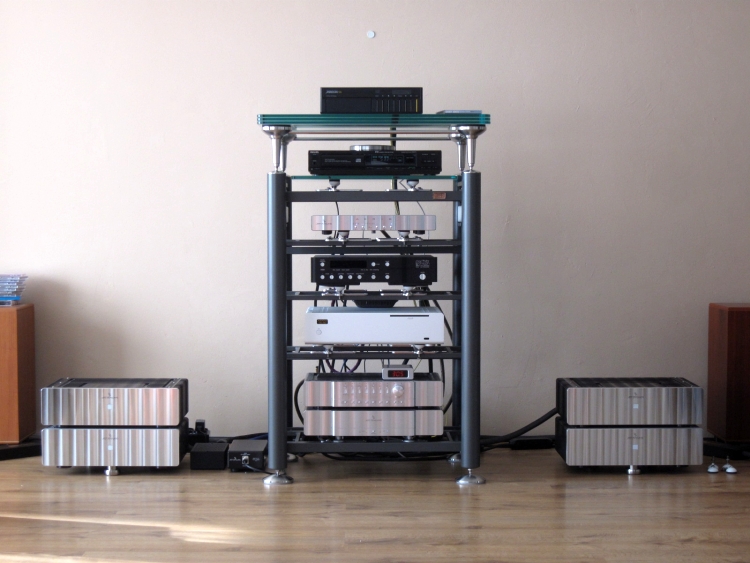
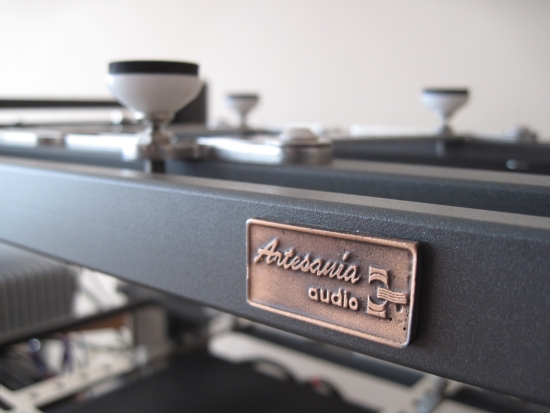
Listening Tests
First thing I wanted to know was how the rack performs from level to level. Some may not be aware of this phenomenon, but all rack I have used, tilt the character of the component from tight to fluid, depending on which level it is placed. The Spider rack for example sounds best when using the top level, no matter whether that is the top level of a 30cm, 60cm or 90cm rack. It is always the toplevel that sounds most free and agile. The Spider’s bottom level by the way makes my equipment sound much too controlled and dry. So big is this effect that I never use the bottom level. Naturally, I was curious to find out how the Artesania would perform from level to level.
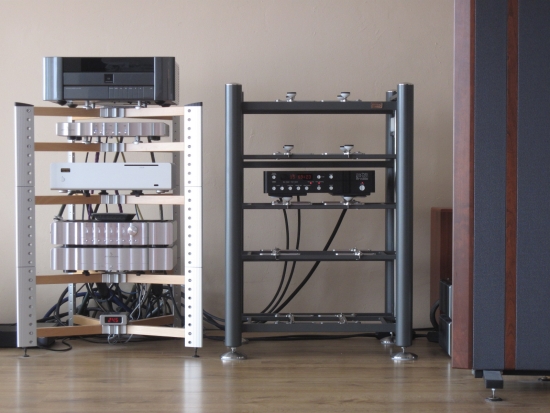
Levinson 390S CD player
First guinea pig was the Levinson 390S CD player, which I moved from top position to bottom position and then back down level by level. Sure enough: there were clear differences in sound and funnily enough they were contrary to the effect that the Spider rack has. Of course, this is only logical because the Spider is most tight at the bottom and most free at the top while for the Artesania Exoteryc this is the reverse because of its suspended “pendular” inner cage. But, with the Exoteryc, the sound never becomes overly tight as it does with the Spider.
The first thing I noticed after placing the Levinson placed on the Exoteryc top level after listening to it on the Spider’s top level, was this immense authority. The sound was much fuller and more harmonic and seemingly a lot of stress had been shedded. The midrange, that was slightly forward with the Spider, was now simply majestic. In fact, the whole sound has this luxurious feel to it, as if I just switched from a Sony CD player to a Jeff Rowland (if they made a CD player…). For all its gloriousness, the sound is absolutely not dull. In fact it is very rhythmic and highly detailed. Low level resolution increases without introducing thinness or shoutiness. Very impressive. Going back made both mine and my listening pal’s mouths fall open. We hadn’t anticipated such a large difference. I was even scared for a typical case of win some – lose some. Definitely not the case here.
The top level, as would later turn out, makes the 390S sound most rhythmic and dynamic, with the best bass but also the most accurate/dry treble of all levels. The bottom level sounds more relaxed and a lot smoother, with very fluid treble. This level is slightly laidback and if I were to use the Levinson on this level then I’d have to do some cable rolling in order to retain the balance. Nothing serious though.
So, if the top level is slightly too dry for the Levinson and the bottom one is slightly too relaxed, certainly the perfect level should be somewhere in-between, right? Yes indeed. It turned out that the second level from the top offers the best balance for the Levinson. Mind you – mileage will vary depending on chosen component and system synergy. Luckily the rack offers lots of tweaking possibilities. For example, if the Levinson was placed on the mid level (third level from the top), it would also be slightly relaxed but this was easily compensated for by sliding out the feet-supporting bars more toward the sides. Voila: more bass articulation while retaining smoothness.
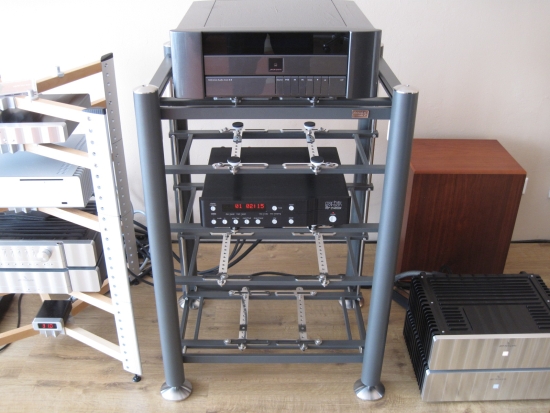
More components
Thus far the rack was occupied only by the Levinson CD player. Now it was time to see how placing a heavy component on top (without connecting it) would influence the sound of the Levinson. The latter btw has its final position on the middle level. Again a big surprise: instead of the expected slight thickening, the sound opened up more. Treble is airier and the whole sounds even more luxurious. To substantiate: removing the Meridian 818 made the sound flatter again. This promised something for when all components were positioned in the rack.
Jeff Rowland Aeris DAC
Reconnecting the Jeff Rowland Aeris DAC to the Levinson’s digital output, as I normally do, made the expected improvement. As can be read in the Aeris review, this DAC is one of the very few to actually improve on the 390S’s sound. The Aeris is made of one solid block of aluminum. It is very heavy and one wouldn’t expect that it would be influenced in any way by the way that it is supported. But guess what? Switching the Aeris from the Spider rack to the Artesania again made for a big improvement. On the Artesania rack, the Rowland sounded even more like a Rowland: smooth and glorious and majestic yet highly neutral. I knew enough. I was done with the Spider and all components were to be moved to the Artesania.
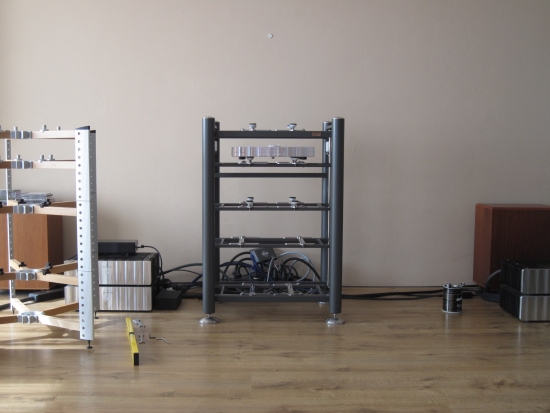
Complete implementation
Setting up really isn’t as complex as you’d think it might be. In fact I find it no more complex than setting up a Spider rack. But if you do need help, there’s a video on youtube that very clearly explains it all. So, the time has come to listen to all components, setup in the Artesania Exoteryc rack. I started with the Aeris in top position and built from there. As long as you make sure that the outer structure is 100 level, then make sure the inner structure is also 100% level, you cannot go wrong. Start out with an imperfectly aligned element and you might end up having to do a whole lot of adjustments later on, so I’d advise to take your time doing the initial setup. It’ll save time in the end. The entire setup including some listening tests in between took me half a day. I guess it could have been a lot quicker if I didn’t evaluate all possibilities on a component per component basis but the same has always been true for the times when I “reformatted” the Spider rack.
One last word on the build quality of the Artesania rack: it is 100% perfect! All elements are manufactured to the highest standards. There is no ringing anywhere, no rough edges and everything is geometrically perfect. The Exoteryc rack is a beautiful object and almost a piece of art and it instills a huge Pride of Ownership. The latter may not come cheap, but you certainly get a massive amount of quality for the outlay.
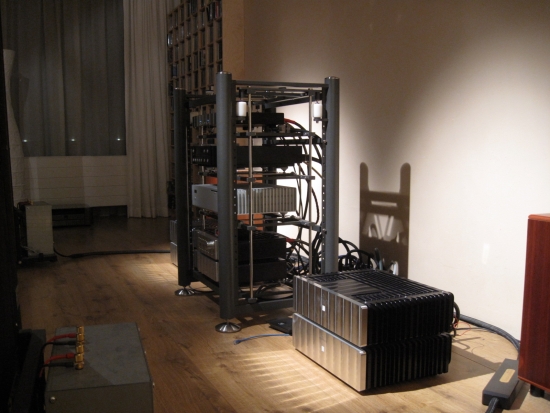
Listening to the entire setup
Oftentimes I conclude that a certain component has been like a teacher to me. The Wadia 861 was such a machine. It tought me about rhythm and about acoustical, natural sound. Once I had grown to love the Wadia-portrayal of piano and percussion, and voices too, many other CD players sounded synthetic to me. I never before knew that the Sony XA50ES sounded a bit “plasticky”. In the same way, the Artesania has been like a teacher to me.
I have heard and used many different audio racks. Heavy ones, light ones, solid ones and floppy ones. One conclusion that I made early on was that wood was not my friend. At least, wooden platters weren’t. MDF was the worst. No matter the brand, wooden equipment supports would always sound colored and oftentimes congested. Heavy racks with lots of damping or sandwiched layers would not color as much but in turn rob the music of its free-flowing quality or reduce dynamics. Cabinets invariably sounded boxy and glass/steel racks would sound too pinched. At one time I actually liked the top levels of a simple steel Target stand, but its other levels very much degraded the sound quality. Which brings me to the other problem that I encountered early on: no matter the brand, every level sounds different depending on the level used. All this brought me to try the Finite Elemente Spider rack. I was immediately smitten for its configurability and uncolored sound. As an added bonus, it increased low level detail, without adding pinch. Or so I thought all of the last 10 years. But I’m getting ahead of myself.
To me, the Spider was the only rack that didn’t add a boxiness to the sound. Sure it sounded a little leaner than most racks but you get a lot in return. The Spider was no different in variance across its levels, but there were various ways to tweak the sound: using ceraballs or rubber feet made a lot of difference, as did the positioning of the feet. Without exception the sound became looser with the feet positioned more toward the center, and tighter toward the outer sides. For the longest time, the Spider would be my rack of choice. I even compared it to the Pagode at some stage, and found that rack to sound colored and restrained dynamically. Go figure.
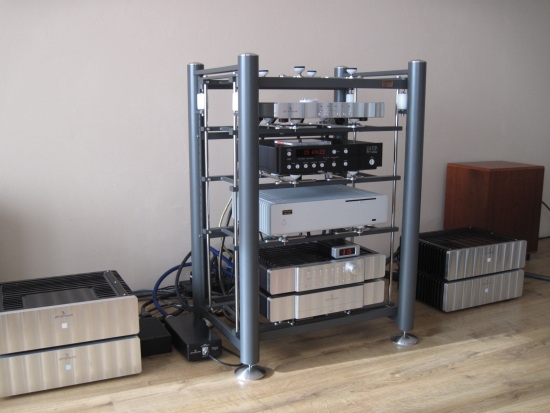
Naturally, system synergy is a major factor in any comparison, but that’s another story. The little intro above brings me back to the Artesania rack. For it, too, turns out to be like a teacher to me. It showed in an instant that the Spider rack was pinched and forward in the midrange and that it apparently shifts energy from the lower octaves into the higher octaves. What’s more: compared to the Artesania, much like a Sony to a Wadia, the Spider rack sounds synthetic! The Spider doesn’t begin to touch on the Artesania’s pure, natural, full-color sound. Even if the Spider rack is on balance a little more airy and agile, it just doesn’t move me anymore after having listened to the Artesania. Such is the life of an audiophile. It is so easy to get used to better sound!
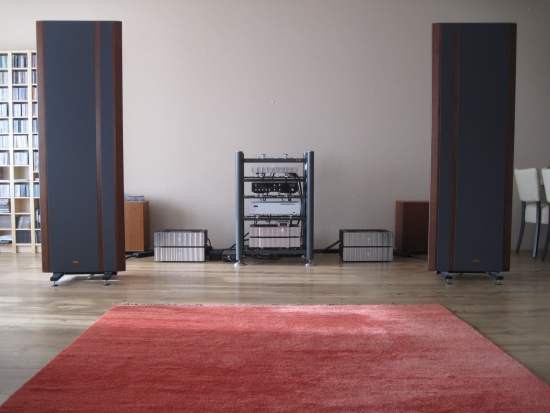

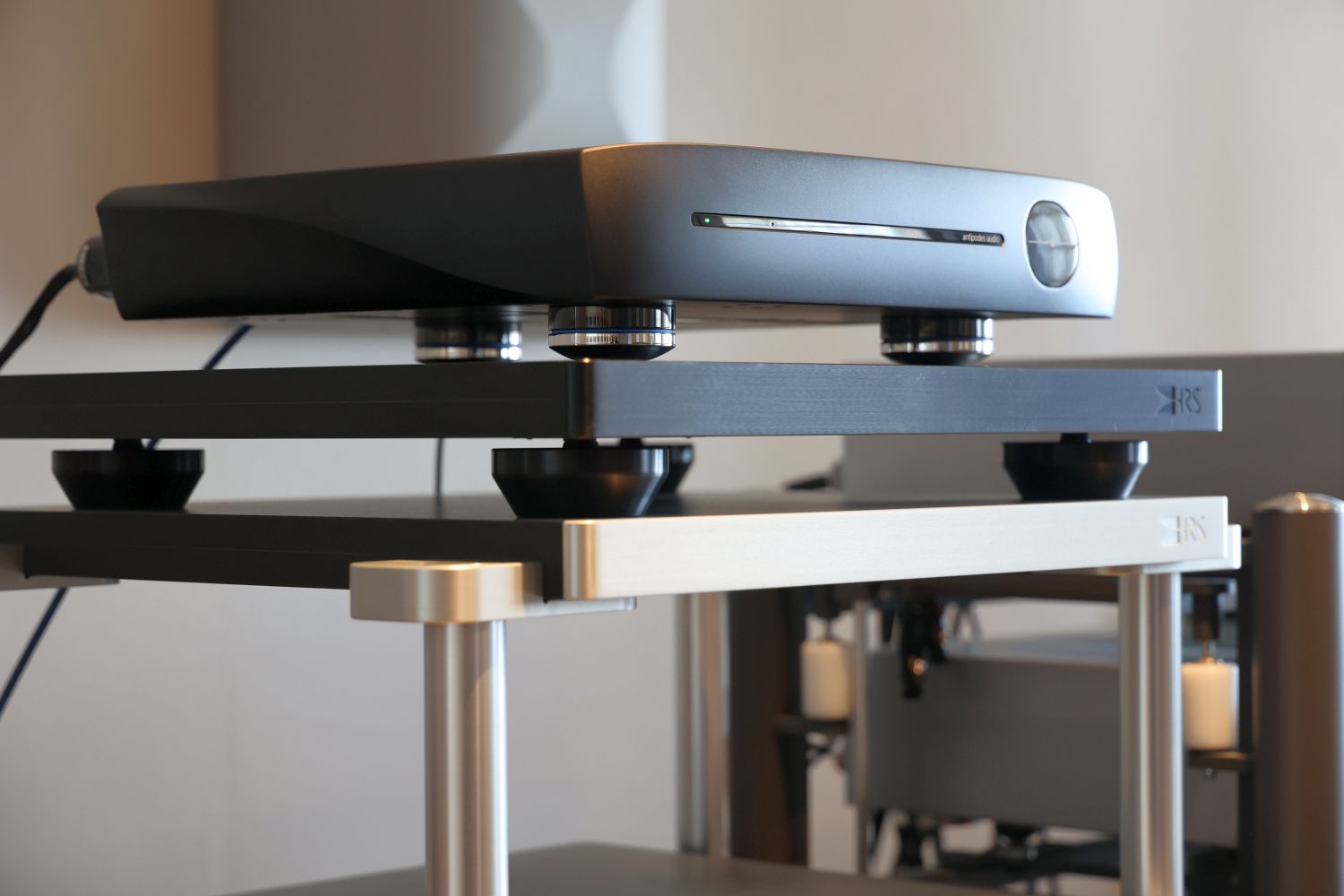


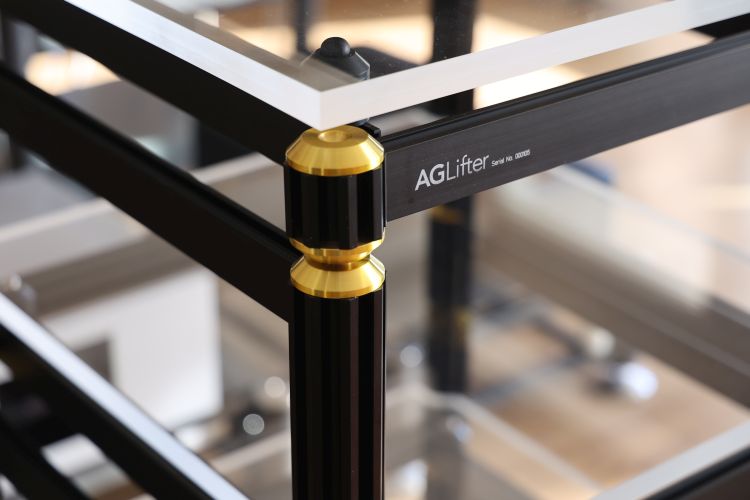
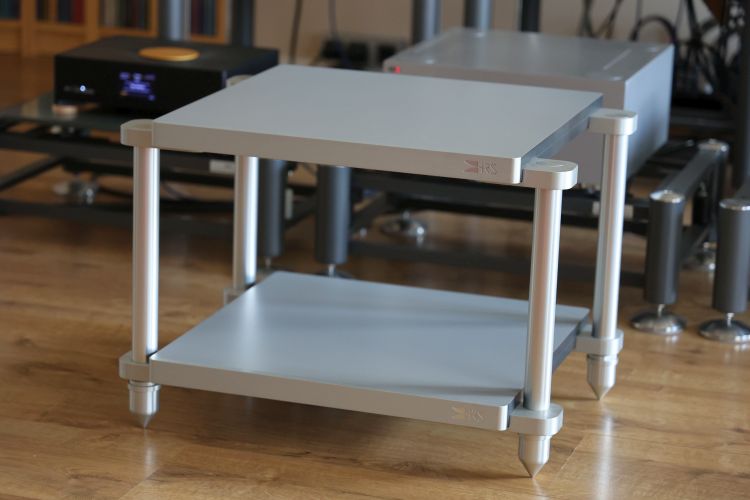
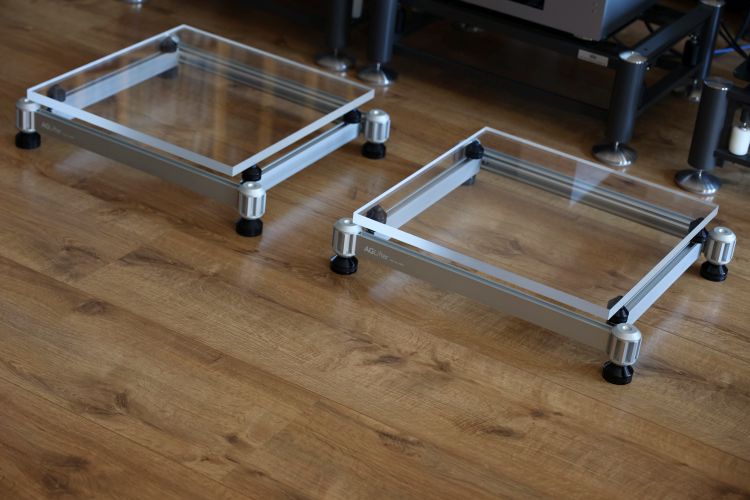
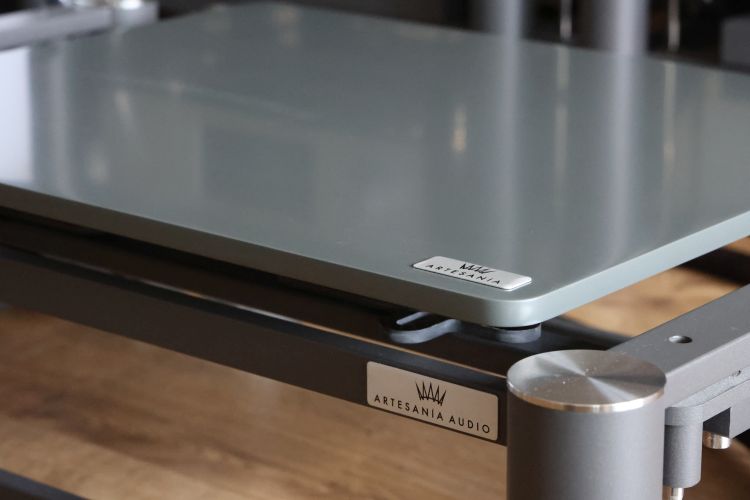
Hi Christiaan,
Can you compare this rack with the A Capella platforms?
Best, G.
Hi Christian, i see you placed the power supplies from rowland not into the rack, but on the ground. Are the power supplies on the ground not bad for the sound?
It does make a considerable difference but I wouldn’t say one is strictly better than the other. The main difference is that power supplies, when placed on the floor, tend to sound bassier and fuller whilst placement on a rack tends to make the sound faster and airier. In my case, I needed the extra body in my system at that time.